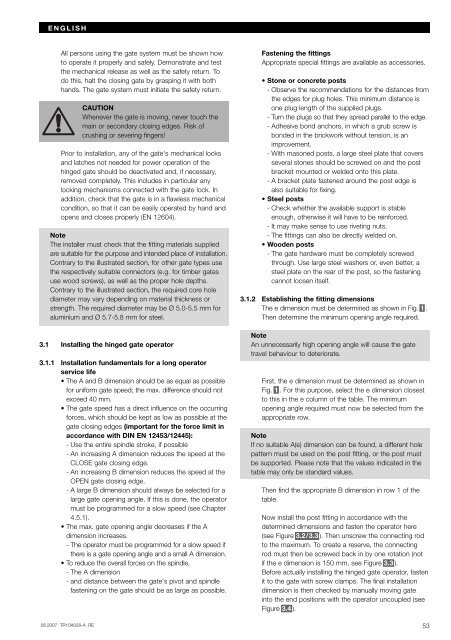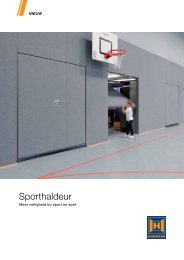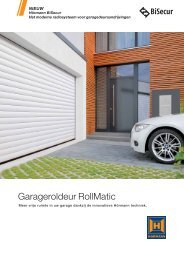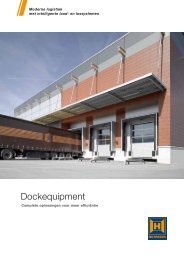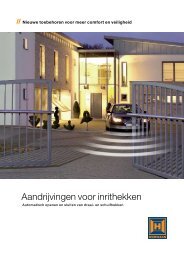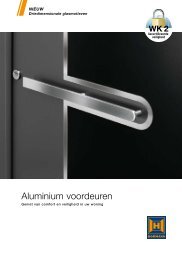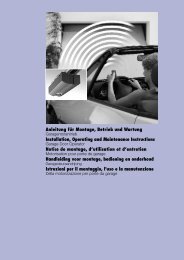2 - Hormann
2 - Hormann
2 - Hormann
Create successful ePaper yourself
Turn your PDF publications into a flip-book with our unique Google optimized e-Paper software.
ENGLISH<br />
All persons using the gate system must be shown how<br />
to operate it properly and safely. Demonstrate and test<br />
the mechanical release as well as the safety return. To<br />
do this, halt the closing gate by grasping it with both<br />
hands. The gate system must initiate the safety return.<br />
CAUTION<br />
Whenever the gate is moving, never touch the<br />
main or secondary closing edges. Risk of<br />
crushing or severing fingers!<br />
Prior to installation, any of the gate's mechanical locks<br />
and latches not needed for power operation of the<br />
hinged gate should be deactivated and, if necessary,<br />
removed completely. This includes in particular any<br />
locking mechanisms connected with the gate lock. In<br />
addition, check that the gate is in a flawless mechanical<br />
condition, so that it can be easily operated by hand and<br />
opens and closes properly (EN 12604).<br />
Note<br />
The installer must check that the fitting materials supplied<br />
are suitable for the purpose and intended place of installation.<br />
Contrary to the illustrated section, for other gate types use<br />
the respectively suitable connectors (e.g. for timber gates<br />
use wood screws), as well as the proper hole depths.<br />
Contrary to the illustrated section, the required core hole<br />
diameter may vary depending on material thickness or<br />
strength. The required diameter may be Ø 5.0-5.5 mm for<br />
aluminium and Ø 5.7-5.8 mm for steel.<br />
3.1 Installing the hinged gate operator<br />
3.1.1 Installation fundamentals for a long operator<br />
service life<br />
• The A and B dimension should be as equal as possible<br />
for uniform gate speed; the max. difference should not<br />
exceed 40 mm.<br />
• The gate speed has a direct influence on the occurring<br />
forces, which should be kept as low as possible at the<br />
gate closing edges (important for the force limit in<br />
accordance with DIN EN 12453/12445):<br />
- Use the entire spindle stroke, if possible<br />
- An increasing A dimension reduces the speed at the<br />
CLOSE gate closing edge.<br />
- An increasing B dimension reduces the speed at the<br />
OPEN gate closing edge.<br />
-A large B dimension should always be selected for a<br />
large gate opening angle. If this is done, the operator<br />
must be programmed for a slow speed (see Chapter<br />
4.5.1).<br />
• The max. gate opening angle decreases if the A<br />
dimension increases.<br />
- The operator must be programmed for a slow speed if<br />
there is a gate opening angle and a small A dimension.<br />
•To reduce the overall forces on the spindle,<br />
- The A dimension<br />
- and distance between the gate's pivot and spindle<br />
fastening on the gate should be as large as possible.<br />
08.2007 TR10A028-A RE<br />
Fastening the fittings<br />
Appropriate special fittings are available as accessories.<br />
• Stone or concrete posts<br />
- Observe the recommendations for the distances from<br />
the edges for plug holes. This minimum distance is<br />
one plug length of the supplied plugs.<br />
-Turn the plugs so that they spread parallel to the edge.<br />
- Adhesive bond anchors, in which a grub screw is<br />
bonded in the brickwork without tension, is an<br />
improvement.<br />
-With masoned posts, a large steel plate that covers<br />
several stones should be screwed on and the post<br />
bracket mounted or welded onto this plate.<br />
-A bracket plate fastened around the post edge is<br />
also suitable for fixing.<br />
• Steel posts<br />
- Check whether the available support is stable<br />
enough, otherwise it will have to be reinforced.<br />
- It may make sense to use riveting nuts.<br />
-The fittings can also be directly welded on.<br />
• Wooden posts<br />
- The gate hardware must be completely screwed<br />
through. Use large steel washers or, even better, a<br />
steel plate on the rear of the post, so the fastening<br />
cannot loosen itself.<br />
3.1.2 Establishing the fitting dimensions<br />
The e dimension must be determined as shown in Fig. 1 .<br />
Then determine the minimum opening angle required.<br />
Note<br />
An unnecessarily high opening angle will cause the gate<br />
travel behaviour to deteriorate.<br />
First, the e dimension must be determined as shown in<br />
Fig. 1 . For this purpose, select the e dimension closest<br />
to this in the e column of the table. The minimum<br />
opening angle required must now be selected from the<br />
appropriate row.<br />
Note<br />
If no suitable A(e) dimension can be found, a different hole<br />
pattern must be used on the post fitting, or the post must<br />
be supported. Please note that the values indicated in the<br />
table may only be standard values.<br />
Then find the appropriate B dimension in row 1 of the<br />
table.<br />
Now install the post fitting in accordance with the<br />
determined dimensions and fasten the operator here<br />
(see Figure 3.2/3.3 ). Then unscrew the connecting rod<br />
to the maximum. To create a reserve, the connecting<br />
rod must then be screwed back in by one rotation (not<br />
if the e dimension is 150 mm, see Figure 3.3 ).<br />
Before actually installing the hinged gate operator, fasten<br />
it to the gate with screw clamps. The final installation<br />
dimension is then checked by manually moving gate<br />
into the end positions with the operator uncoupled (see<br />
Figure 3.4 ).<br />
53


